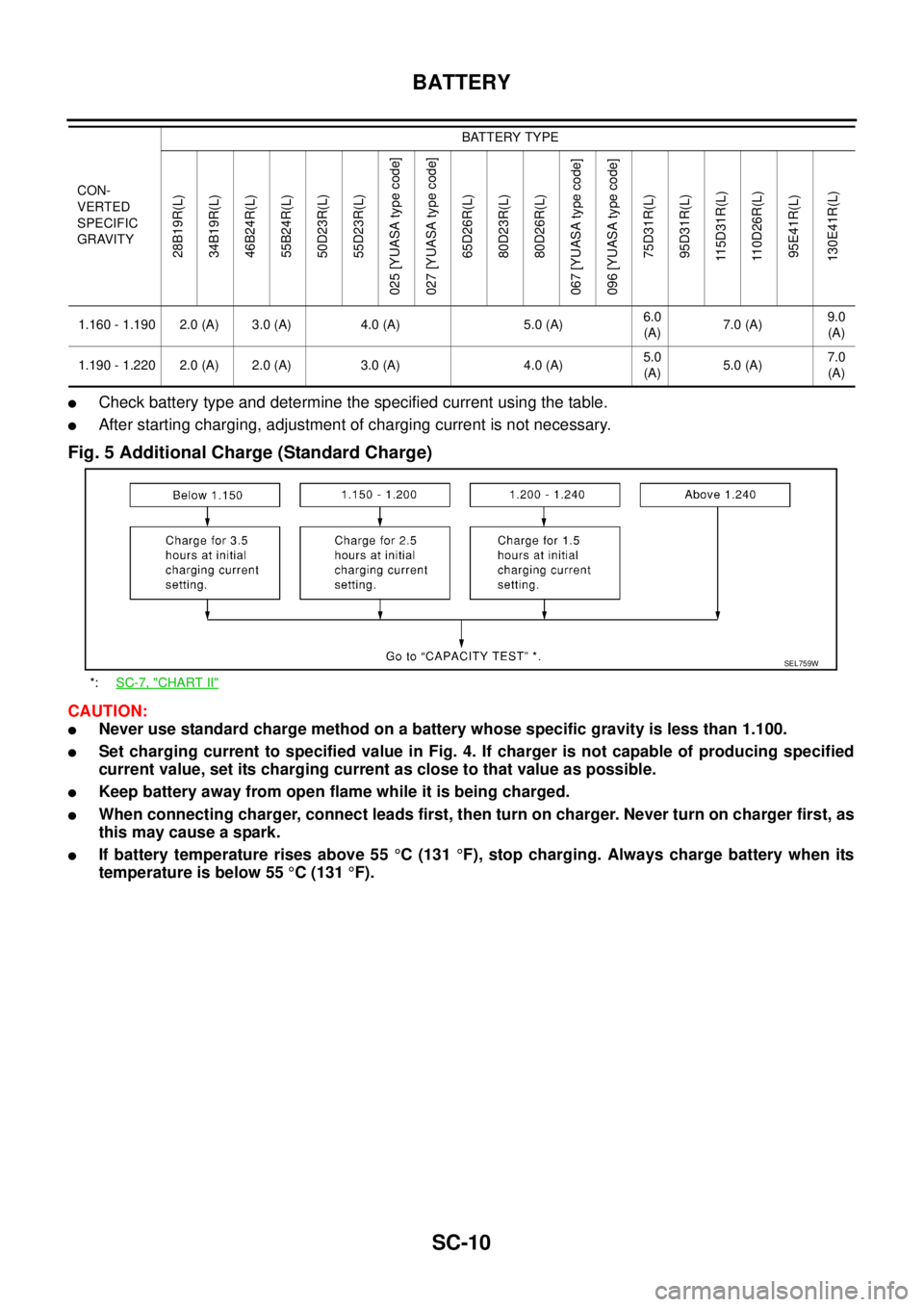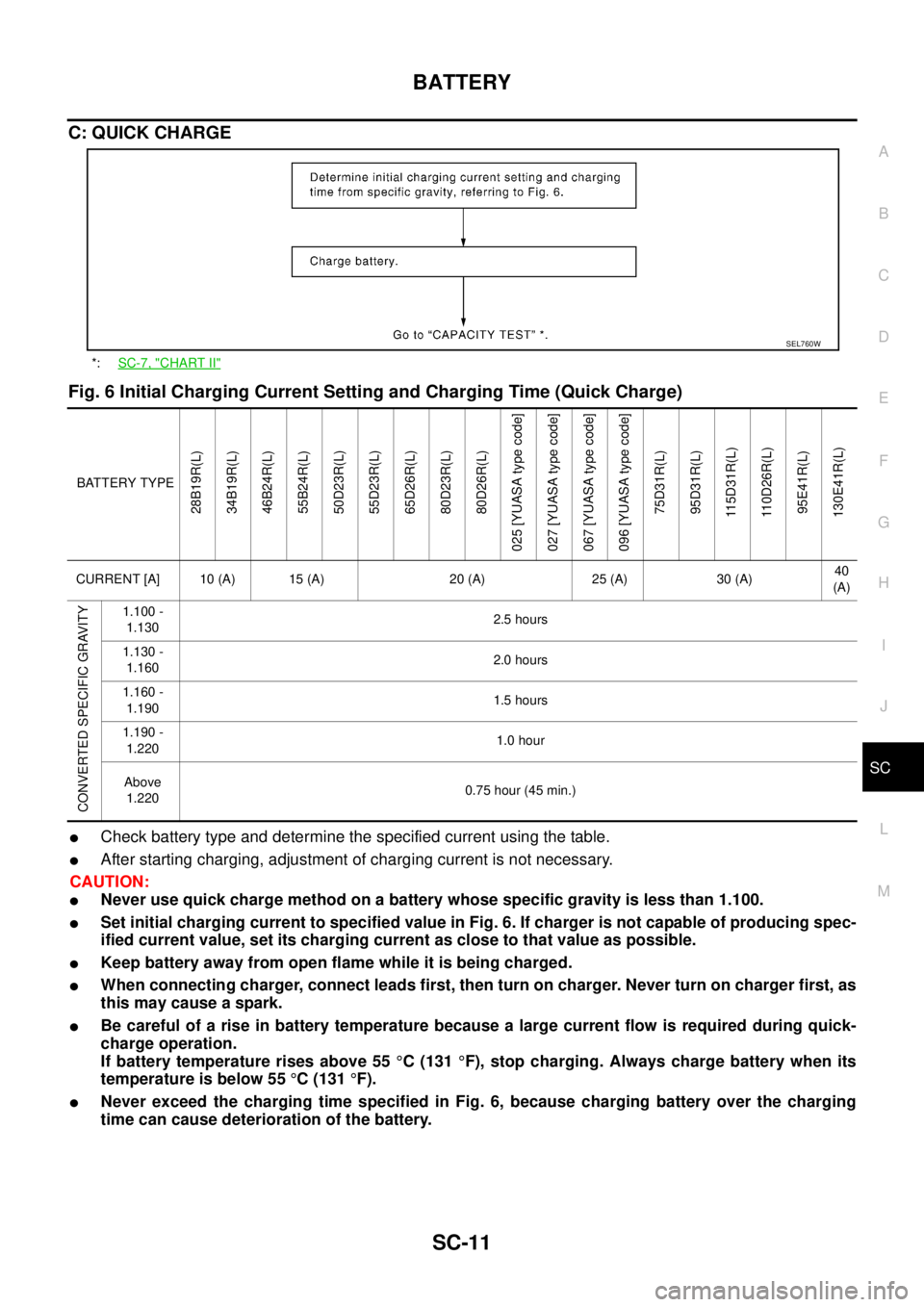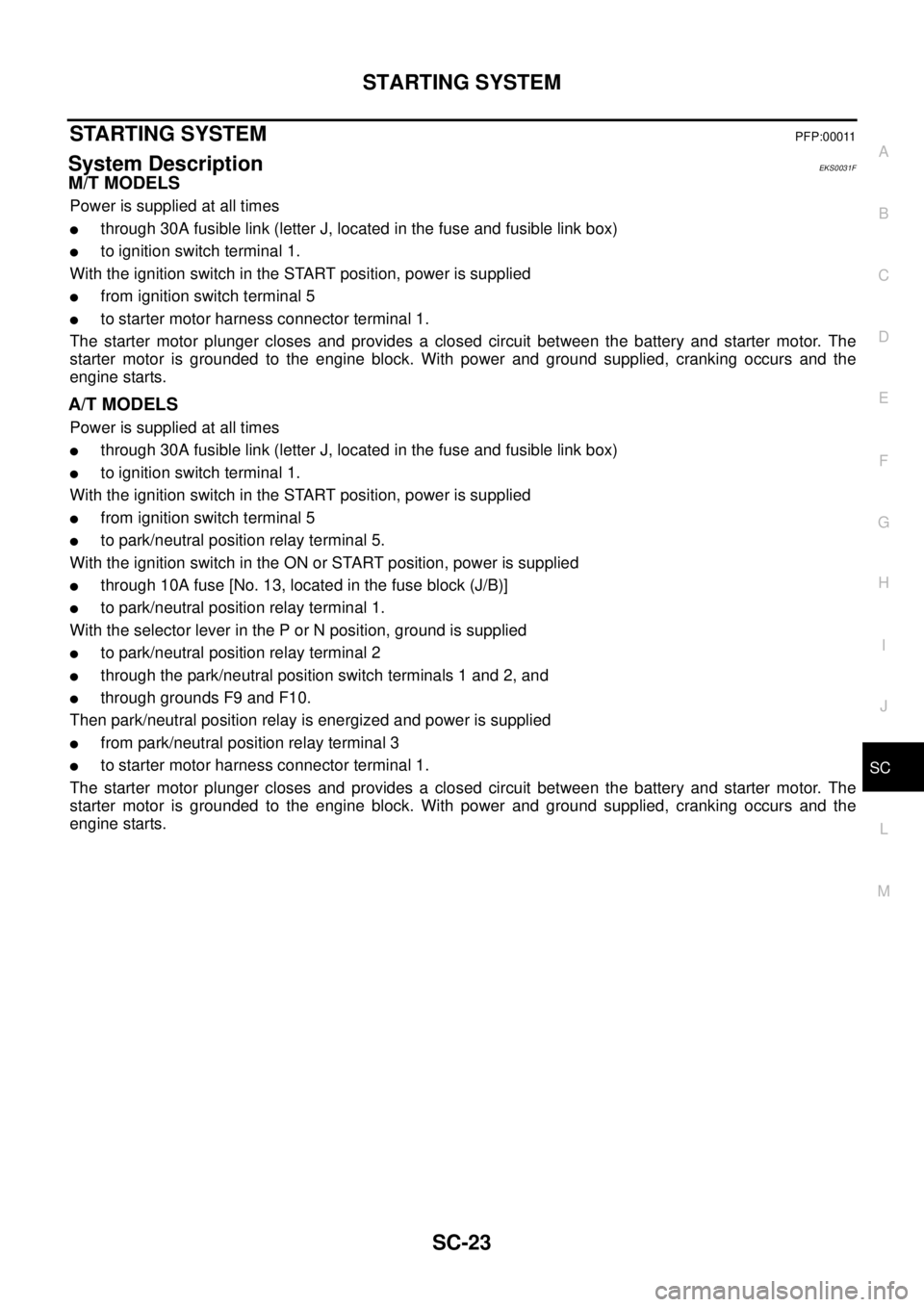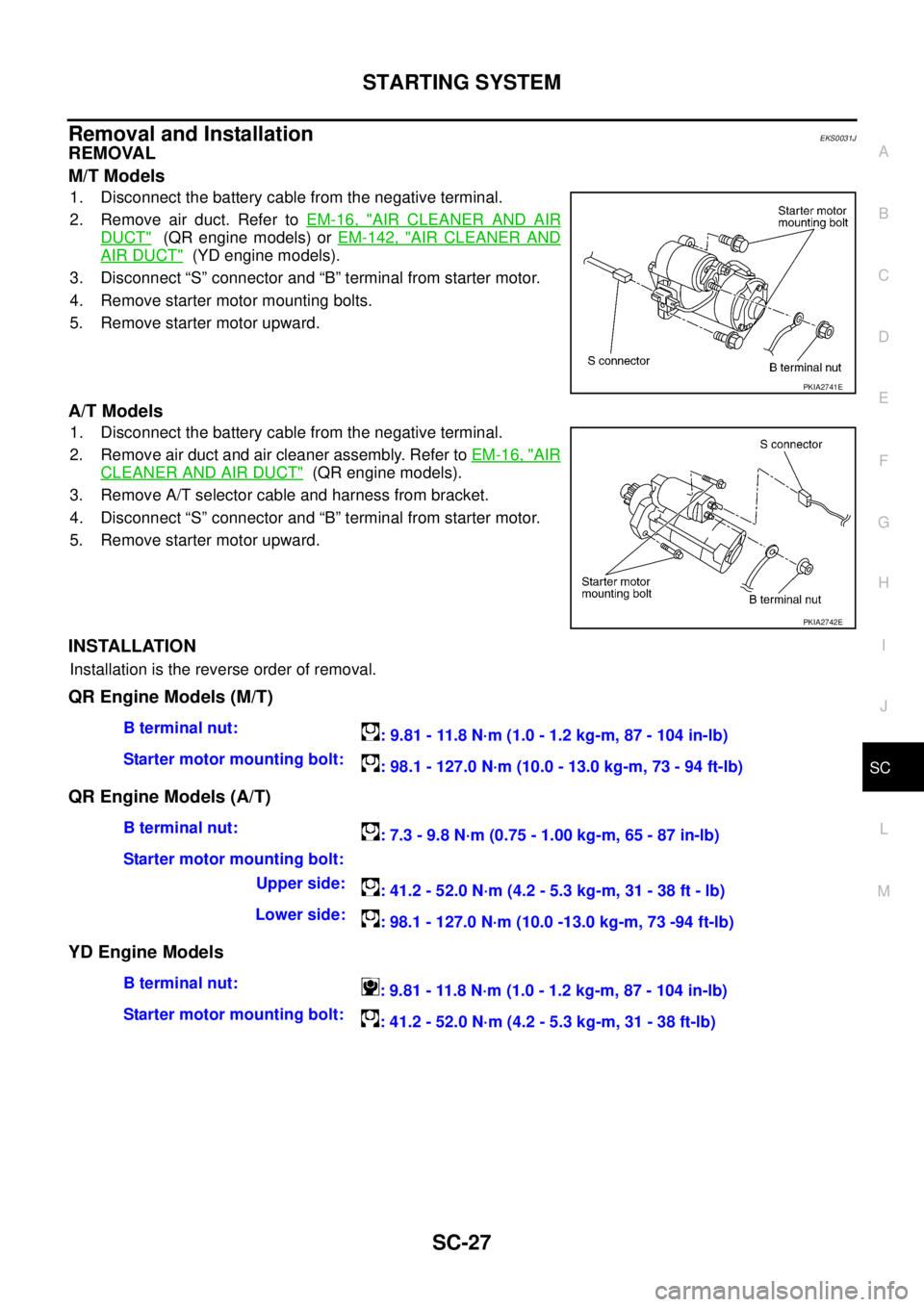Page 3970 of 4555

SC-10
BATTERY
�Check battery type and determine the specified current using the table.
�After starting charging, adjustment of charging current is not necessary.
Fig. 5 Additional Charge (Standard Charge)
CAUTION:
�Never use standard charge method on a battery whose specific gravity is less than 1.100.
�Set charging current to specified value in Fig. 4. If charger is not capable of producing specified
current value, set its charging current as close to that value as possible.
�Keep battery away from open flame while it is being charged.
�When connecting charger, connect leads first, then turn on charger. Never turn on charger first, as
this may cause a spark.
�If battery temperature rises above 55 °C (131 °F), stop charging. Always charge battery when its
temperature is below 55 °C (131 °F).
1.160 - 1.190 2.0 (A) 3.0 (A) 4.0 (A) 5.0 (A)6.0
(A)7.0 (A)9.0
(A)
1.190 - 1.220 2.0 (A) 2.0 (A) 3.0 (A) 4.0 (A)5.0
(A)5.0 (A)7.0
(A) CON-
VERTED
SPECIFIC
GRAVITYBATTERY TYPE
28B19R(L)
34B19R(L)
46B24R(L)
55B24R(L)
50D23R(L)
55D23R(L)
025 [YUASA type code]
027 [YUASA type code]
65D26R(L)
80D23R(L)
80D26R(L)
067 [YUASA type code]
096 [YUASA type code]
75D31R(L)
95D31R(L)
115D31R(L)
110D26R(L)
95E41R(L)
130E41R(L)
*:SC-7, "CHART II"
SEL759W
Page 3971 of 4555

BATTERY
SC-11
C
D
E
F
G
H
I
J
L
MA
B
SC
C: QUICK CHARGE
Fig. 6 Initial Charging Current Setting and Charging Time (Quick Charge)
�Check battery type and determine the specified current using the table.
�After starting charging, adjustment of charging current is not necessary.
CAUTION:
�Never use quick charge method on a battery whose specific gravity is less than 1.100.
�Set initial charging current to specified value in Fig. 6. If charger is not capable of producing spec-
ified current value, set its charging current as close to that value as possible.
�Keep battery away from open flame while it is being charged.
�When connecting charger, connect leads first, then turn on charger. Never turn on charger first, as
this may cause a spark.
�Be careful of a rise in battery temperature because a large current flow is required during quick-
charge operation.
If battery temperature rises above 55 °C (131 °F), stop charging. Always charge battery when its
temperature is below 55 °C (131 °F).
�Never exceed the charging time specified in Fig. 6, because charging battery over the charging
time can cause deterioration of the battery.
*:SC-7, "CHART II"
SEL760W
BATTERY TYPE
28B19R(L)
34B19R(L)
46B24R(L)
55B24R(L)
50D23R(L)
55D23R(L)
65D26R(L)
80D23R(L)
80D26R(L)
025 [YUASA type code]
027 [YUASA type code]
067 [YUASA type code]
096 [YUASA type code]
75D31R(L)
95D31R(L)
115D31R(L)
110D26R(L)
95E41R(L)
130E41R(L)
CURRENT [A] 10 (A) 15 (A) 20 (A) 25 (A) 30 (A)40
(A)
CONVERTED SPECIFIC GRAVITY
1.100 -
1.1302.5 hours
1.130 -
1.1602.0 hours
1.160 -
1.1901.5 hours
1.190 -
1.2201.0 hour
Above
1.2200.75 hour (45 min.)
Page 3976 of 4555
SC-16
CHARGING SYSTEM
Trouble DiagnosisEKS00319
Before performing an alternator test, make sure that the battery is fully charged. A 30-volt voltmeter and suit-
able test probes are necessary for the test. The alternator can be checked easily by referring to the Inspection
Ta b l e .
�Before starting, inspect the fusible link.
�Use fully charged battery.
WITH IC REGULATOR
NOTE:
�If the inspection result is OK even though the charging system is malfunctioning, check the “B” terminal
connection. (Check the tightening torque and voltage drop.)
�Check condition of rotor coil, rotor slip ring, brush and stator coil. If necessary, replace malfunctioning
parts with new ones.
MALFUNCTION INDICATOR
The IC regulator warning function activates to illuminate charge warning lamp, if any of the following symp-
toms occur while alternator is operating:
�Excessive voltage is produced.
�No voltage is produced.
PKIA3570E
Page 3983 of 4555

STARTING SYSTEM
SC-23
C
D
E
F
G
H
I
J
L
MA
B
SC
STARTING SYSTEM PFP:00011
System Description EKS0031F
M/T MODELS
Power is supplied at all times
�through 30A fusible link (letter J, located in the fuse and fusible link box)
�to ignition switch terminal 1.
With the ignition switch in the START position, power is supplied
�from ignition switch terminal 5
�to starter motor harness connector terminal 1.
The starter motor plunger closes and provides a closed circuit between the battery and starter motor. The
starter motor is grounded to the engine block. With power and ground supplied, cranking occurs and the
engine starts.
A/T MODELS
Power is supplied at all times
�through 30A fusible link (letter J, located in the fuse and fusible link box)
�to ignition switch terminal 1.
With the ignition switch in the START position, power is supplied
�from ignition switch terminal 5
�to park/neutral position relay terminal 5.
With the ignition switch in the ON or START position, power is supplied
�through 10A fuse [No. 13, located in the fuse block (J/B)]
�to park/neutral position relay terminal 1.
With the selector lever in the P or N position, ground is supplied
�to park/neutral position relay terminal 2
�through the park/neutral position switch terminals 1 and 2, and
�through grounds F9 and F10.
Then park/neutral position relay is energized and power is supplied
�from park/neutral position relay terminal 3
�to starter motor harness connector terminal 1.
The starter motor plunger closes and provides a closed circuit between the battery and starter motor. The
starter motor is grounded to the engine block. With power and ground supplied, cranking occurs and the
engine starts.
Page 3984 of 4555
SC-24
STARTING SYSTEM
Wiring Diagram — START — /M/T ModelsEKS0031G
TKWA0056E
Page 3985 of 4555
STARTING SYSTEM
SC-25
C
D
E
F
G
H
I
J
L
MA
B
SC
Wiring Diagram — START — /A/T ModelsEKS0031H
TKWA0057E
Page 3986 of 4555
SC-26
STARTING SYSTEM
Trouble DiagnosisEKS0031I
If any malfunction is found, immediately disconnect the battery cable from the negative terminal.
SEL761W
Page 3987 of 4555

STARTING SYSTEM
SC-27
C
D
E
F
G
H
I
J
L
MA
B
SC
Removal and Installation EKS0031J
REMOVAL
M/T Models
1. Disconnect the battery cable from the negative terminal.
2. Remove air duct. Refer to EM-16, "
AIR CLEANER AND AIR
DUCT" (QR engine models) or EM-142, "AIR CLEANER AND
AIR DUCT" (YD engine models).
3. Disconnect “S” connector and “B” terminal from starter motor.
4. Remove starter motor mounting bolts.
5. Remove starter motor upward.
A/T Models
1. Disconnect the battery cable from the negative terminal.
2. Remove air duct and air cleaner assembly. Refer to EM-16, "
AIR
CLEANER AND AIR DUCT" (QR engine models).
3. Remove A/T selector cable and harness from bracket.
4. Disconnect “S” connector and “B” terminal from starter motor.
5. Remove starter motor upward.
INSTALLATION
Installation is the reverse order of removal.
QR Engine Models (M/T)
QR Engine Models (A/T)
YD Engine Models
PKIA2741E
PKIA2742E
B terminal nut:
: 9.81 - 11.8 N·m (1.0 - 1.2 kg-m, 87 - 104 in-lb)
Starter motor mounting bolt:
: 98.1 - 127.0 N·m (10.0 - 13.0 kg-m, 73 - 94 ft-lb)
B terminal nut:
: 7.3 - 9.8 N·m (0.75 - 1.00 kg-m, 65 - 87 in-lb)
Starter motor mounting bolt:
Upper side:
: 41.2 - 52.0 N·m (4.2 - 5.3 kg-m, 31 - 38 ft - lb)
Lower side:
: 98.1 - 127.0 N·m (10.0 -13.0 kg-m, 73 -94 ft-lb)
B terminal nut:
: 9.81 - 11.8 N·m (1.0 - 1.2 kg-m, 87 - 104 in-lb)
Starter motor mounting bolt:
: 41.2 - 52.0 N·m (4.2 - 5.3 kg-m, 31 - 38 ft-lb)